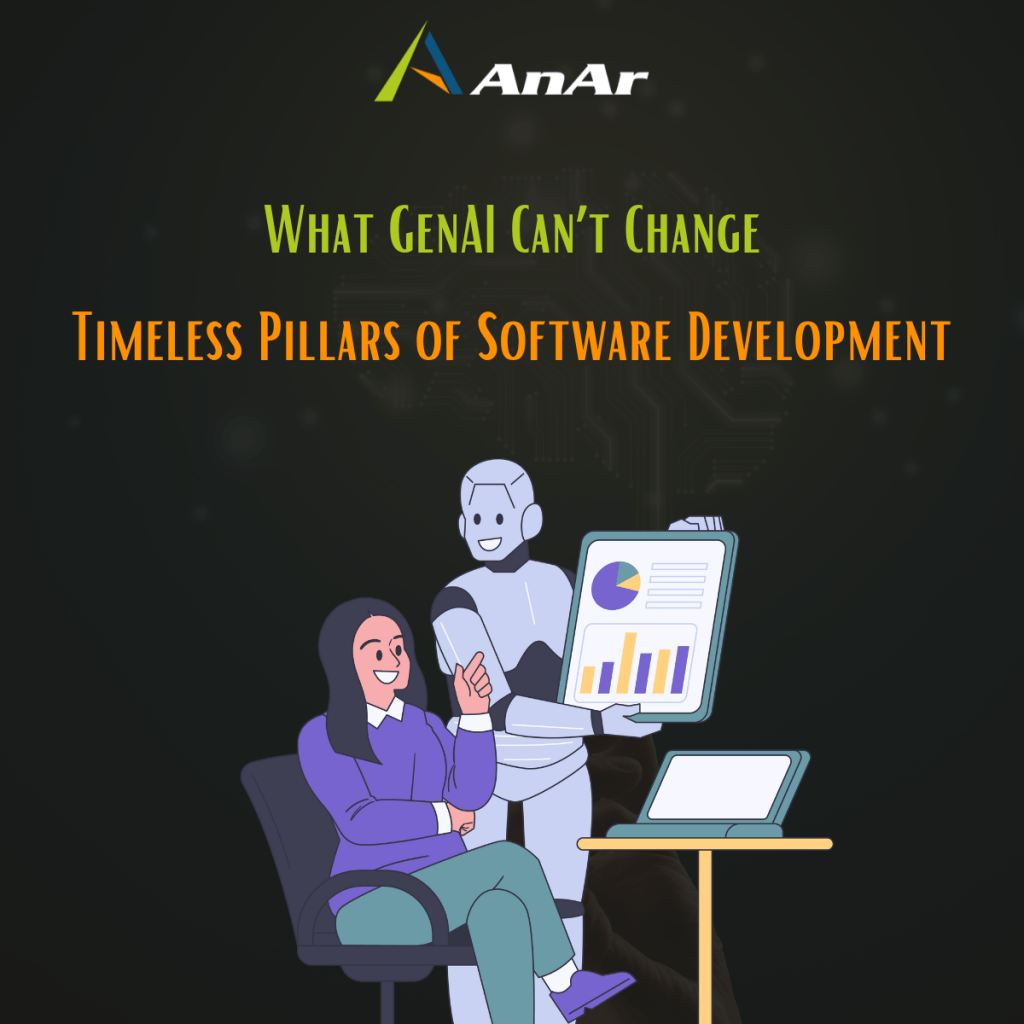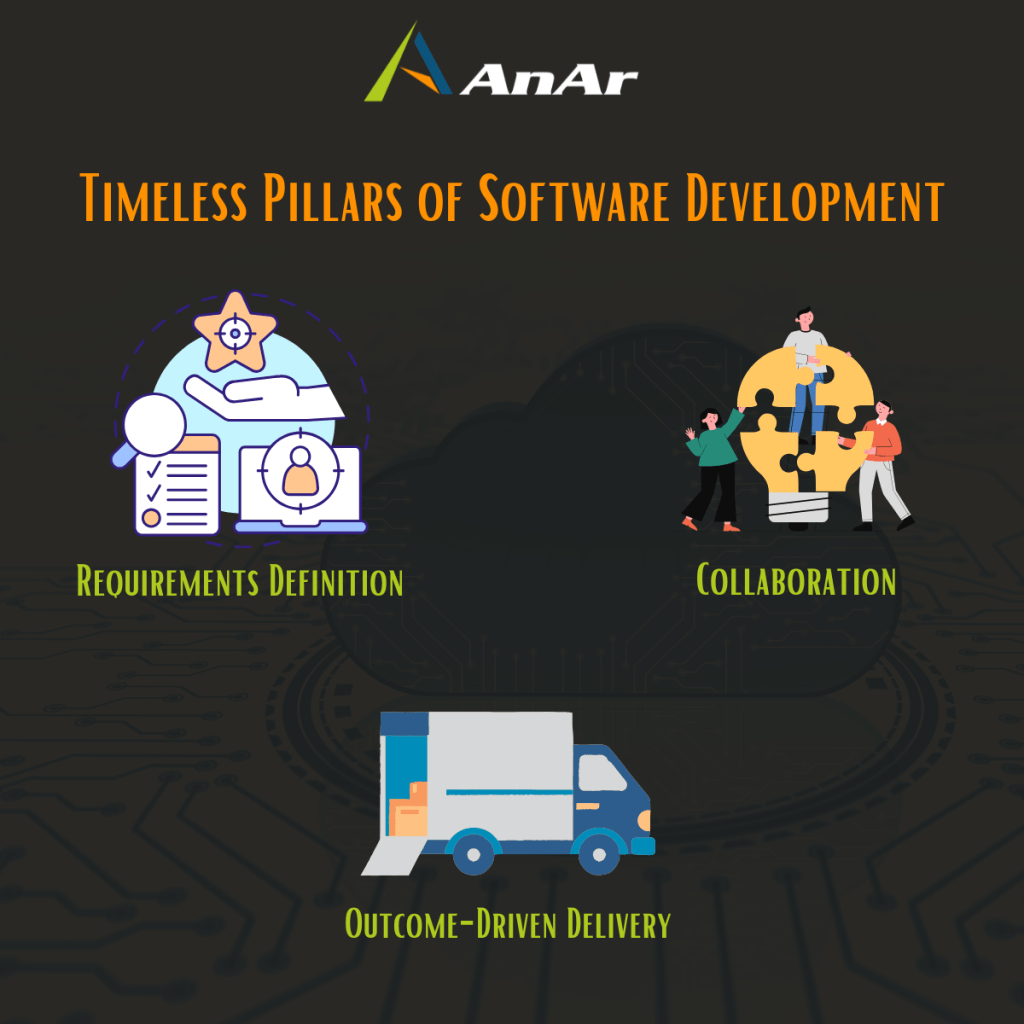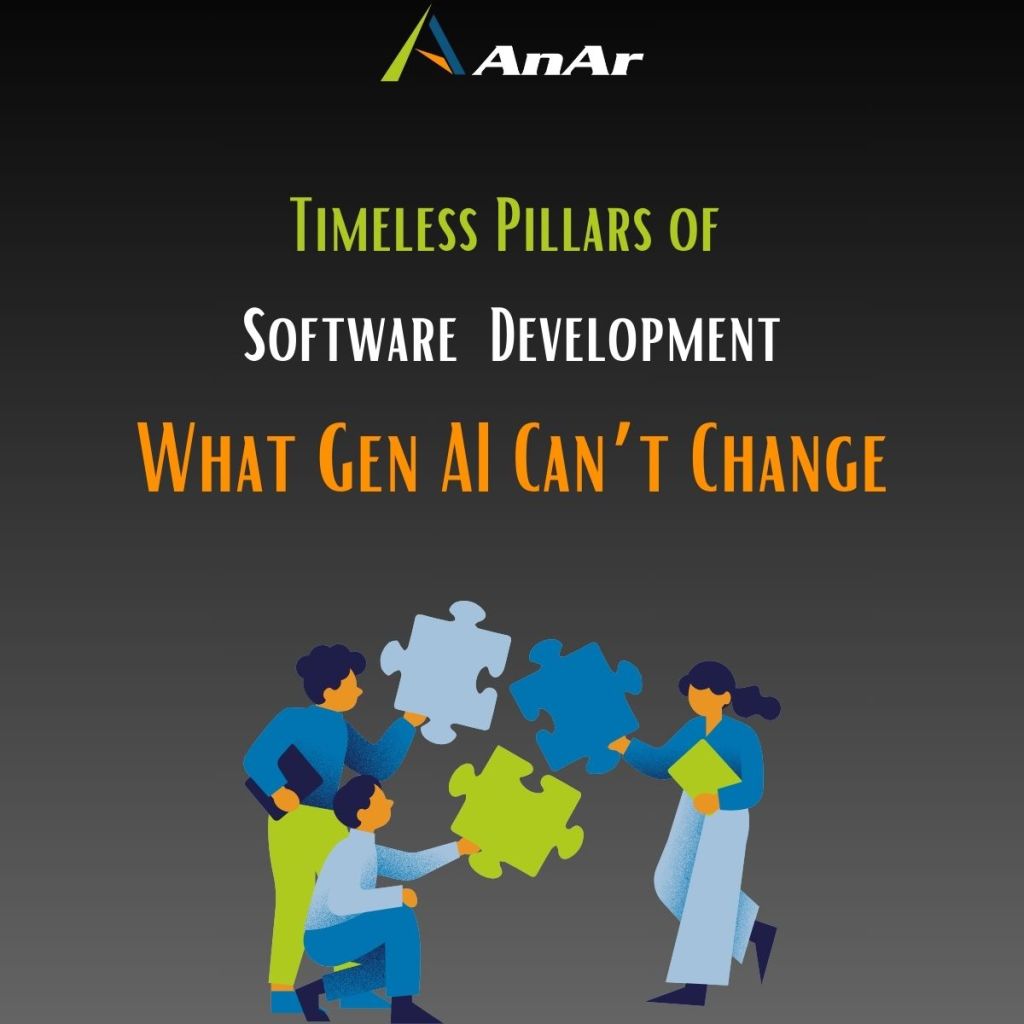The rise of Generative Artificial Intelligence (Gen AI) in software development has generated both enthusiasm and caution. The promise of streamlined coding and automation is exciting, yet it brings forth a critical question: what core principles of software creation remain steadfast, impervious to even the most advanced AI capabilities? This question leads to a comforting insight: certain foundational elements in software development endure, unaffected by evolving technologies.
This discussion spotlights three essential pillars that stand resilient against the wave of Gen AI. These pillars, shaped by years of practical experience and refined by generations of developers, not only guide us through the AI-driven landscape but form the essential backbone that sustains it.
Let’s embark on a voyage of exploration, diving into the fundamental principles and unraveling the hidden knowledge they possess.
Three Timeless Pillars of Software Development
1. Requirements Definition Remains Key
Generative Artificial Intelligence (Gen AI) has introduced a wave of excitement in software development, with promises of rapid code generation and efficiency gains. Yet, the foundation of successful software remains rooted in one crucial element: precise and comprehensive requirements.
In the Gen AI era, this principle is more vital than ever. Ambiguous requirements lead to, at best, functional but underwhelming results, and at worst, stalled projects that waste valuable time and resources. Gen AI may be a powerful engine, but without a clear direction, it’s adrift without purpose.
To guide this technological journey, clarity, thoroughness, and feasibility in requirements are essential. Prioritize core features, involve stakeholders to build a shared vision, and leverage tools like user stories, use cases, and prototypes to bring precision to the process.
Let’s take an example of the Mars Rover Software
NASA’s Mars Rover missions serve as a prime example of the critical role that clear requirements play in software development. The software that guides these rovers across the Martian terrain is built on meticulously defined specifications. The complex interaction between hardware and software necessitates precision to ensure successful navigation, effective sample collection, and reliable data transmission. Despite the sophisticated technology involved, the clarity of requirements is essential to prevent mission failures and enhance scientific outcomes.
For intricate projects, formal requirement specifications may be indispensable. It’s important to remember that precise requirements go beyond merely leveraging AI; they are the foundation of any successful software initiative. By investing in this crucial phase, your AI-powered project will achieve a high level of functionality and user satisfaction.
Even in the Gen AI era, the timeless pillar of clear requirements remains unshakeable. So, before succumbing to the allure of automated code, remember: a well-defined requirement is worth its weight in gold, guiding your project towards success in any technological landscape.
2. Collaboration in Software Development
While Generative AI (Gen AI) promises an automated symphony of code, the enduring conductor of software development remains human collaboration. No virtuoso algorithm can replicate the vital interplay of communication, diverse perspectives, and empathetic understanding that orchestrates successful projects.
Agile methodologies and dedicated tools facilitate seamless knowledge sharing and idea flow. Diverse teams inject innovation and ensure solutions resonate with a wider audience. Collaborative sessions and user testing cultivate empathy, leading to software that truly connects. Effective leadership ensures tasks are aligned, progress monitored, and challenges tackled as a united front.
Let’s understand the significance of collaboration at each phase of the software development lifecycle.
- Team Formation: Ensuring a collaborative team formation is crucial to bring together diverse skills and perspectives. Collaboration at this stage ensures that various viewpoints are considered from the outset, fostering a holistic approach to problem-solving and idea generation.
- Initial Collaboration: During the initial stages, collaboration is vital for sharing insights and aligning the team’s understanding of the project goals. Brainstorming sessions and user story development involve collective input, laying the foundation for a shared vision among team members.
- Design Collaboration: Design collaboration ensures that the app features are not only technically feasible but also user-friendly. Collaboration between designers and developers facilitates the creation of wireframes and prototypes that seamlessly integrate functionality and aesthetics, enhancing the overall user experience.
- Development Phase: Agile sprints, daily stand-up meetings, and code reviews promote continuous collaboration. Developers work closely, sharing progress, discussing challenges, and collectively ensuring that the real-time chat feature is developed efficiently and meets quality standards.
- Testing and Quality Assurance: Collaborative testing involves the entire team, including developers, testers, and designers. This collaborative effort helps identify and address issues promptly, ensuring that the real-time chat feature meets both functional and design requirements.
- Feedback and Iteration: Establishing a feedback loop and conducting retrospectives are collaborative activities that involve the entire team. Collaboration in this phase ensures that the team learns from each iteration, continuously improves processes, and incorporates valuable insights from team members and stakeholders.
- Deployment and Post-Launch: Collaborative monitoring and support post-launch involve the entire team. Quick response to any issues and ongoing support require collaboration to maintain the feature’s reliability. Continuous collaboration with users post-launch ensures that the platform adapts to evolving needs and provides a positive user experience.
Example: Open-source projects like Linux Kernel Development
The collaborative nature of open-source projects, such as the development of the Linux kernel, underscores the indispensable role of human collaboration. Thousands of developers worldwide contribute to the Linux kernel, showcasing the power of diverse perspectives and collective problem-solving. While automated tools aid in code review and integration, the essence of collaboration extends beyond lines of code. It involves shared visions, community discussions, and the orchestration of a harmonious blend of talents to create a robust and reliable operating system.
Remember, Gen AI augments, not replaces. The software symphony thrives on the unique human strengths that AI cannot replicate. By promoting a culture of open communication, diverse perspectives, and empathetic understanding, we ensure that the human conductor continues to lead the technological orchestra, long after the Gen AI fanfare fades.
Gen AI enhances our work but doesn’t replace the human touch that’s key in software development.
3. Outcome-Driven Delivery and Agile Methodology
Generative AI promises to propel software development into uncharted waters, but two timeless guideposts remain crucial: outcome-driven delivery and agile methodology. These principles ensure our voyage delivers value, not just lines of code, navigating the turbulent seas of change even as AI reshapes the landscape.
Outcome-Driven Delivery: The Fixed Star
Software isn’t just functionality; it’s a tool built to achieve specific goals. Outcome-driven delivery keeps these goals front and center, recalibrating our course to reach the desired destination. Gen AI can be a powerful engine, but without a clear destination, even the fastest journey is meaningless.
Agile Methodology: The Adaptable Compass
Rapid change demands frequent course corrections. Agile methodologies provide the compass for these adjustments. Through iterative cycles of development and feedback, we adapt to user needs, embrace failures as learning opportunities, and refine our approach until the desired outcome is achieved. Gen AI can accelerate these cycles, but the human hand remains firmly on the tiller, steering towards successful outcomes.
Let’s understand this with an e-Commerce Platform Feature Rollout
Consider a new e-commerce platform designed to maximize user engagement and boost sales. An outcome-driven approach would focus on features that elevate the shopping experience and increase conversion rates. Using an agile methodology, the platform would adopt iterative development cycles, frequent releases, and quick adjustments informed by user feedback. For example, the platform might introduce a feature that enables users to virtually “try on” clothing items using augmented reality. Through continuous refinement and attentive monitoring of user interactions, this feature can evolve to meet customer expectations and drive sales growth. This approach illustrates how outcome-driven delivery and agile methodologies extend well beyond music streaming, proving their value in achieving user-centric goals across diverse sectors.
Technology is meant to serve, not dictate. Outcome-driven delivery and agile practices are more than industry buzzwords; they are tried-and-true strategies for adapting to an evolving software landscape. By prioritizing user needs, embracing iteration, and learning from challenges, we ensure that our software delivers meaningful value, no matter the technological shifts around us.
Conclusion
The enduring pillars of Clear Requirements, Collaboration, and Outcome-Driven Delivery through Agile Methodology guide our path with steadfast reliability. At AnAr Solutions, we place these foundational principles above the allure of Gen AI alone. To us, successful software creation goes beyond cutting-edge technology; it’s about establishing clear direction, fostering collaborative innovation, and achieving outcomes that truly resonate with users. As your trusted partners in software excellence, we approach innovation with a purpose. Our commitment to human-centered principles ensures that the solutions we deliver are not only technically robust but also built to withstand the test of time.







